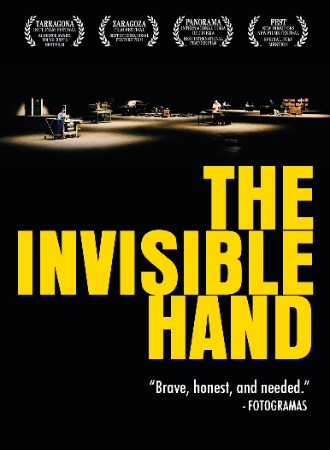
The Invisible Hand 2016
Distributed by Pragda, 302 Bedford Ave., #136, Brooklyn, NY 11249
Produced by David Macián
Directed by David Macián
Streaming, 83 mins
High School - General Adult
Communication; Labor; Sociology
Date Entered: 06/02/2020
Reviewed by Kimberly Poppiti, St. Joseph's College, Patchogue, NYThe Invisible Hand is an 83 minute-long feature film based on the 2012 novel by Isaac Rosa. The action is set in a warehouse wherein a group of individual workers assemble repeatedly in order to complete repetitive tasks individually before an unseen, but sometimes heard, audience.
The world created on screen in The Invisible Hand mingles and intercuts the seemingly everyday actions of the various assembled workers (who complete tasks such as sewing garments, inputting data into a computer, conducting telephone surveys, and building a wall), to create a mixture of theatricality and everyday realism on film. When the vocal reactions of the live audience are incorporated, the lines between theatrical and filmic performance become increasingly blurred. As the film proceeds, viewers gain insight into the lives of the workers. Each individual is shown to toil diligently, although not without complaint, at their assigned task. The workers complete diverse everyday tasks that at first seem unrelated, but which are soon revealed to all share one common factor: although the tasks are product-oriented, once the work of each character is completed, the product of their labor is destroyed or thrown out.
Throughout the film, scenes of employees at work at their individual stations are interwoven with excerpts from their job interviews and snippets of conversations in which they express frustration at the pointlessness of their labors, especially when faced with increasing output quotas and monitoring. The progression of these scenes is somewhat non-linear and some divisions between workers arise, but viewers should be able to understand the general progression of the workers from unhappy individuals to a somewhat unified, but increasingly unhappy, group. This aspect of the film’s development provides interesting examples of communication and conflict resolution.
Viewers are likely to empathize with the workers in regard to the futility of their labor. It is easy to understand the frustrating alienation of the workers from any useful product of that labor, and viewers are likely to recognize the cruelty of the workplace in which the workers slog along without recognition or reward. Some viewers may also extrapolate and relate the action on stage/screen to the titular metaphor or other larger labor, societal, and/or communication-related issues. These viewers will take the greatest benefit from the film. Other viewers may be challenged by the subject matter or the filmmakers’ storytelling style, which combines a non-traditional narrative style with limited character development of individual members of the ensemble cast. These viewers may struggle to understand or engage with the film on a meaningful level.
The Invisible Hand is presented in Spanish, with English subtitles available. It includes a few instances of potentially offensive language, including racial slurs. The film also features numerous graphic scenes of raw meat being butchered onstage, these include the headless (but otherwise intact) carcass and partially butchered (but still recognizable) head of a pig. A detailed study guide for this film is available online and this is likely to be a useful viewing aid. This film is most likely to be of interest to those in the fields of Communication, Labor, and Sociology, as well as to some in the fields of Experimental Film and Theatre.
Awards:
Tarragona International Film Festival - Audience Award, Young Jury's Best Film; Zaragoza Film Festival - Best International Feature Film; Panorama Internacional Coisa de Cinema - Best International Feature Film; Cinespaña - Festival du Film Espagnol de Toulouse - Best New Director